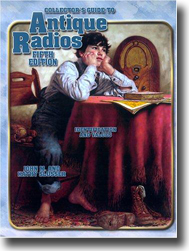 Collector's Guide to Antique Radios
Collector's Guide to Antique Radios by John Slusser & the Staff of Radio Daze. 5th edition (2002)
I don't have much use for price lists. Pricing is far too varied to be representative of what you'd see in reality; but at least they do give you a heads up whether a given radio is generally valuable or generally dime-a-dozen. Though it never seems to keep the local antique co-op from pricing a 60s GE clock radio as if it were a catalin Fada.
This one is listed in "database" format, in other words, it's mainly a text listing of makes and models with a little bit of info. E.g. Zenith 5-G-500, portable, 1941, cloth covered, inner right black dial, left grille, fold-down front, handle, 2 Z knobs, BC, 5 tubes, AC/DC/battery....$25-30. So if you've got a Zenith 5-G-500 it'll tell you the year it was made and couple other pieces if info you may not know, but that's it. If you have a radio that's without identification markings (and we've all seen those), you ain't gonna find it in here. There are some photos, but far, far fewer than listings.
I've got the 5th edition. The 7th (2008) and can be purchased and downloaded as a PDF from the publisher's website.
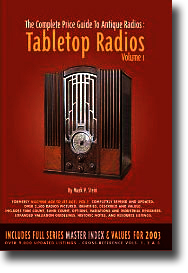 The Complete Price Guide to Antique Radios
The Complete Price Guide to Antique Radios by Mark V. Stein (various editions and volumes)
My review here is actually for a collection of books by Mark Stein, and it can be confusing. There was a multiple volume set called Machine Age to Jet Age: Radioman's Guide to Tabletop Radios. It appears that everything is now being collected under the Complete Price Guide to Antique Radios marquee and Machine Age to Jet Age is now Tabletop Radios Volume 1. As far as I know, subsequent volumes of Machine Age to Jet Age haven't been updated yet.
Stein's also written a number of other collector's guides to various radios under various titles. I'm just going to treat them all together as one here.
Unlike David & Betty Johnson's Guide to Old Radios, this is pretty-much all price guide and little else. I don't have much use for price guides per se (prices are quickly obsoleted and often don't reflect the prices I see); where this shines is that it's not just a list of makes and models, it has photos of each. This makes it extraordinarily useful in identifying old radios. A lot of times you may have a make but no model—these books give you photos so you can visually identify it. It won't tell you more than a make, model, year it was made and a price, but it's a start.
The problem with any collector's guide named "complete" is that it isn't, expecially when you're dealing with multiple volumes. My Hoffman A300-like radio isn't listed in Volume 1, and Hoffman as a make doesn't appear at all in Volume 2 (I haven't bought subsequent volumes yet).
That said, many radios are pictured and it's worth checking out.
A note on Cathedral & Tombstone Radios: the book is smaller format 6"x9", as opposed to 8-1/2"x11" for the others), but otherwise the same in form and content.
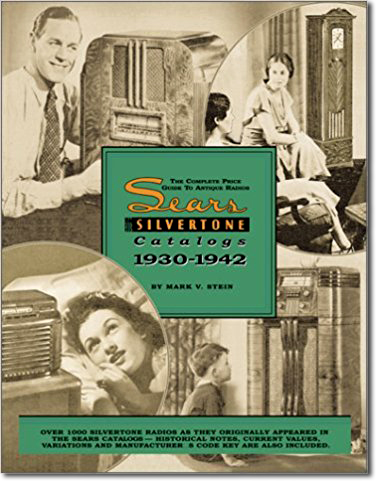 The Complete Price Guide to Antique Radios—Sears Silvertone Catalogs: 1930-1942
The Complete Price Guide to Antique Radios—Sears Silvertone Catalogs: 1930-1942by Mark V. Stein
Even though Mark Stein wrote this, and it's part of his Complete Price Guide series, it's different enough that I felt it needed a separate review.
Sears may be circling the drain these days, but for decades they were the dominant retailer in the USA, and they sold a lot of radios under their house brand, Silvertone. Since Sears produced catalogs of their merchandise to serve their mail order customers, most of their radios appeared there.
This book covers only the era from 1930 to 1942, which leaves out a lot of Silvertones, but it does cover the heart of the antique years. The book is divided by year, and it appears that all the radio pages from the catalogs are included.
There's also an appendix that lists the manufacturers and Sears's codes. Sears used a 3-digit manufacturer's code, followed by a dot and then a model number. So Silvertone chassis marked 300 were made by Stewart-Warner, 301s were made by Colonial, and so forth. Nice to know if you want to learn a little more about your set.
I was a bit disappointed by this book, however. I've got three Silvertones and none of them are in it. One is from 1925 and that's fair enough. The second one is something I'm trying to identify. But the third one is my 1937 console and it's not in there at all, but it should be. Maybe it didn't appear in the catalog, but either way, this bothers me.
Still, I'm glad I bought the book and would recommend it to anyone interested in Silvertones. I assume Stein meant to come out with a subsequent volume from 1943 onward, but never did. A shame. And I wish there were one for Montgomery Wards Airline radios as well.
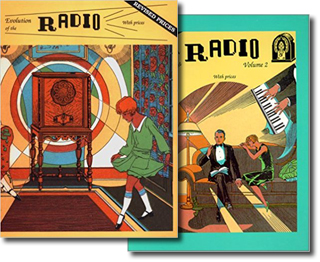 Evolution of the Radio, Volumes 1 and 2
Evolution of the Radio, Volumes 1 and 2 Edited by Scott Wood. 1991-1993.
Another set of price guides, long-since made obsolete by time and the internet. Like most price guides, there are photos of selected models and in the rear there's a section with appraised pricing. The price lists take up only a small portion of the book. The radio photos are better than most other guides because they're all in color and larger, which makes it a bit easier to tell similar radios apart.
But as a collector's guide, it has far too few radios to be of great value: you're better off with the Mark Stein books.
The "evolution" in the title is, in my opinion, misleading because it doesn't really go into how or why the radio developed as it did. David & Betty Johnson's Guide to Old Radios does a better job of that.
What does set this book apart is the collection of old advertising at the front of each volume. The ads are taken from magazines or catalogs, and feature line drawings of various models of radios, along with the advertisers' descriptions and, usually in the catalog pages, pricing. A lot of the major brands like RCA, Zenith and Philco are less represented here, but you can find a lot of information about those makes in other books. Evolution of the Radio's ads feature a lot of lesser tier brands like Sonora, Packard Bell, Lafayette, Sentinel and such. Many of the ads appear to be from old Sears and Montgomery Ward catalogs, which isn't a bad thing since many Silvertones and Airlines are still around, and these ads are the only information available for these radios.
Volume 1 has a much larger section of ads than Volume 2, and for that reason I recommend Volume 1 more. I'm luke-warm on both books, but as I type this, they're typically available from Amazon.com under $10 each, so they're budget friendly.
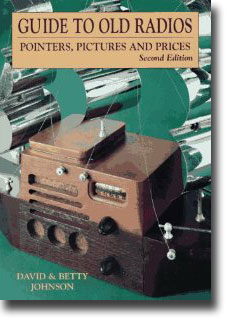 Guide to Old Radios: Pointers, Pictures and Prices
Guide to Old Radios: Pointers, Pictures and Prices by David & Betty Johnson. 2nd Edition, 1995.
I generally don't care much for price guides, and because this is relatively old, the price guide portion is far out of date. What makes this worthwhile is that the price guide is only half the book. The other half is a keeper.
The Johnsons don't just list radio makes and models, the first half of the book is a short history of the development of radio. While the parts on broadcasting history are interesting but irrelevent, the actual development of radio is important because it teaches you the evolution of design, both in cabinets and chasses. If you read those chapters, you'll have a far better eye for determining when a given radio was manufactured and why. You'll know why radios in the 20s had three huge knobs and two smaller ones, and what the A, B and C batteries were for. You'll get a sense of why radios in the 20s and early 30s were ornate, when tuning eyes and telephone dials were in vogue, and why plastic bodies ultimately became king.
There's also some practical advice on judging radios. Besides the obvious (radios with missing knobs are less valuable; radios with missing trim should be avoided because you may never find a replacement), they discuss the difference between Bakelite and Catalin, Urea and Styrene plastics and how they affect value. Overall, I found it an enlightening and interesting read.
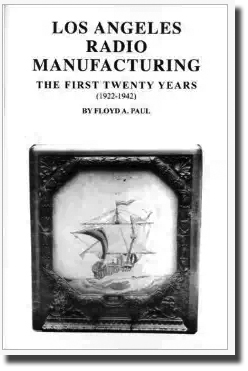 Los Angeles Radio Manufacturing: The First Twenty Years (1922-1942)
Los Angeles Radio Manufacturing: The First Twenty Years (1922-1942)by Floyd A. Paul. 1999. Includes Suppliments 1 and 2.
All the other books I've reviewed here are relatively easy to find (Amazon.com and eBay are good sources); but this book (actually a collection of three: the main book and two suppliments are sold together) is only sold directly through the Southern California Antique Radio Society (SCARS), and they're a bit pricey ($42.99), so I'm going to review it in a little more detail than I have the others.
The early west coast radio manufacturing scene was different than what went on in the East and Midwest during the same time. A company called Gilfillan Brothers managed to get the exclusive RCA patent rights for 11 western states. At that time, RCA controlled virtually every useful patent, so if you wanted to make and sell a radio that worked, you had to get RCA's blessing to do it.
What happened was the West's cottage radio industry of the 20s and 30s clustered around Gilfillan's (accent on the 2nd syllable) Los Angeles plant. Manufacturers had to work out a deal (and deals seemed to differ) with Gilfillan to get licensed, usually by having at least some of the manufacturing work done at the plant.
On some level, these books are very similar to Alan Douglas's Radio Manufacturers of the 1920s books. But whereas Douglas's books are large format and perfect bound, Paul's books are pamplet style and staple bound (saddle stitch). Printing is monochrome but the paper quality is very good. The print quality is fine, the photo reproductions are so-so, and the schematics are a little too small. It is heavily illustrated with a nice mix of advertising, product photos, a few schematics that aren't available in Rider's Troubleshooter books, and ephemera (such as a Gilfillan Brothers stock certificate).
Like Douglas's books, they are primarily organized alphabetically by manufacturer. Unlike Douglas's books, which lean more heavily on documentation from advertising and info from trade magazines, Paul's book sources are more often former employees and people who recall the era first-hand. There's less detail on sales and revenue and more on personalities and work experience.
The only real disappointment with the books is the way they're organized. It appears to me to be a collection of articles that probably appeared first in the SCARS newsletters, and then were gathered here to make these books. Since the articles appear alphabetically by manufacturer, there's a huge amount of redundant information regarding the Gilfillan-RCA patent deal, and things don't really come clear until one gets to the Gilfillan chapter. I think the book would be more readable if Gilfillan had been first and the other manufacturers appeared afterward, and the prose for the others tailored to remove some of the redundant storytelling. Douglas has a similar problem because of the role of Hazeltine's Neutrodyne patents, but it's particularly noticable in Paul's books.
There's also a thread about Los Angeles being the "midget capital of the world," because so many of the LA manufacturers built the super-small tabletop or "mantle" models. The Midget Capital of the World Listings, in my opinion, should have appeared first (even before Gilfillan) in the first book. Instead it's in the 1st suppliment between articles on "The Mobile Addressophone" and "LA Notable Quotations of 1931 and 1932".
But if you can get past the eccentric organization, there's a lot of interesting information that is simply unavailable elsewhere. If you find Los Angeles radios interesting and you want to know more about Gilfillan, Jackson-Bell, Mission-Bell, Packard-Bell, Peter Pan, Herbert Horn and others, this is just about the only place you'll find anything about them.
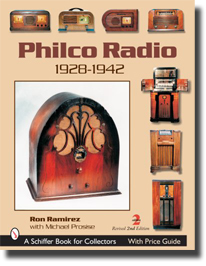 Philco Radio: 1928-1942
Philco Radio: 1928-1942 by Ron Ramirez. 2nd Edition, 2006.
If you are familiar with the Zenith books, you'll recognize this. This covers the early and glory years of the Philadelphia Storage Battery Company as they rapidly rose to become an industry leader and RCA's primary nemesis. It's the company that's synonymous with the cathedral style (they called it the Baby Grand). The post World War II world was less kind to Philco, and the decline is covered briefly in a final chapter.
Physically it's large, nicely bound, with slick pages and heavily illustrated, including a lot of color photographs. The text is small so you'll need your good specs or a bright reading lamp.
The book is organized by year, beginning with a run-down of what happened, and then lists (and shows) each model that came out that year, along with specs and a photo. Salt-and-peppered throughout are period advertisments.
One of the appendices offers something I've not seen before, a model-by-model tube-layout diagram, which is basically a box with the proportions of the chassis and little circles for each tube placed in their relative positions. If you have a Philco chassis with no identification, this may help you determine which model it is.
It's a very nicely done book. If you're a Philco fan or want to know more about them, it's an excellent resource.
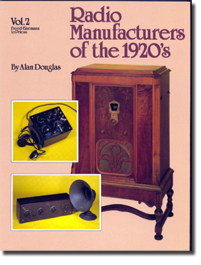 Radio Manufacturers of the 1920s
Radio Manufacturers of the 1920sby Alan Douglas. 1988. Volumes 1 through 3.
This 3-volume set is a brief history of various radio companies that began, or at least had their heyday, in the nineteen twenties. This was the period of RCA's stranglehold on the Armstrong regenerative, superheterodyne, and Alexanderson TRF patents (among many others), and of Hazeltine's Neutrodyne patent; if you wanted to make a modern, decent radio, you infringed on one or more of those patents and needed to buy a license. And RCA (in particular) did not automatically sell a license to anyone who wanted it.
It's also the era of rapid technological advancement, and of several booms and busts in the industry before the big disaster waiting in the fall of 1929. Many of the companies would start off strong and disappear overnight. A few managed to become giants. Only a couple are still around today.
Manufacturers are presented in their own chapters alphabetically. Volume 1 begins with AC Dayton and ends with J.B. Ferguson; Volume 2 documents Freed-Eisemann through Priess; Volume 3 begins with RCA and wraps up with Zenith.
The information available varies widely depending on what the author was able to scrounge. Some companies like RCA, Philco and Atwater Kent are well documented; others are little more than what could be gleaned from advertising in trade magazines. The book is heavily illustrated with advertising from each company. Data, however, vary greatly. Some companies have annual revenue and sales figures, others are little more than just a handful of advertising copy.
The information is well presented and written. My only real quibble with the book is the organization. As I mentioned at the beginning, so much of what went on in this period involves the RCA patent pool and Hazeltine's Neutrodyne circuit. It would have been useful, and answered many questions in advance, if a chapter had been written at the beginning to clearly lay out the situation and its progression. Then when each manufacturer is presented, what they were doing regarding licensing one way or another would already be put into context. Instead, it's briefly touched on in the introduction, and it's discussed largely as it applies to each manufacturer in their individual chapters, so you have to read a lot of the book before you can really get the big picture of what was going on.
This is not a collector's guide. Except in a few cases, there are no master lists of models and specifications, and definitely no modern price guide. It's a book aimed mostly at the radio historian or hobbyist who enjoys history, rather than a merchant who simply wants to price an antique for sale. If you are the former, they are excellent books and highly recommended if you like that period of radio history; if you're the latter, you'd be better off with one of the many collector's guides.
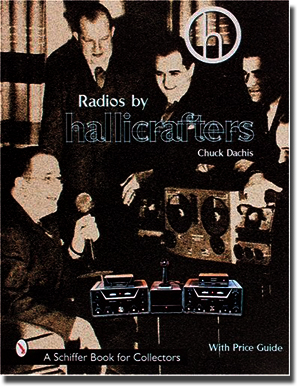 Radios by Hallicrafters
Radios by Hallicraftersby Chuck Dachis. 2nd edition, 1999.
I have a sentimental attachment to Hallicrafters, because their SX-42 was my first serious boat anchor receiver, and their HT-40 my first boat anchor transmitter. There was no way I was not going to get this book.
It starts with a brief history of the company and some notes on restoration, then launches into the meat of the book, a model by model description, with a decent sized, clear photo, along with a blurb on the features of the rig. Models are organized by series, starting with the S/SX receivers and ending with some unmarked items. After that he includes promotional items, displays and advertising (including the famous Fidel Castro print ad).
There's also a geneology of the ubiquitous S-38. As mentioned in 73 Magazine (March 1966), have you ever met a ham who hasn't had an S-38 once?
What's missing is a current guide to pricing, which as far as I'm concerned is largely worthless and not needed anyway.
You're not going to get a full history of Hallicrafters, not the way you do in the RCA or Zenith books, but for a model-by-model description, it's great. If you're a Hallicrafters fan, it's definitely worth owning.
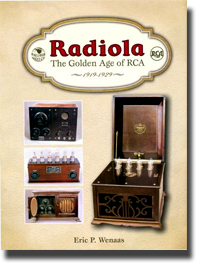 Radiola: The Golden Age of RCA (1919-1929)
Radiola: The Golden Age of RCA (1919-1929)by Eric P. Wenaas. 2007.
If it were a little larger I'd call it a coffee-table book. For a fairly obscure subject (RCA radios from the 1920s), it's a beautifully made book. The pages are slick, it's heavily illustrated both in b&w and color, and it's thick—weighing in at 475 pages. Very little of it is the sort of filler you find in a lot of these kinds of books: there are a few tables of models and specifications; most of it looks like a fat article in a quality magazine about RCA and their products.
RCA is a fascinating company and its early history touches nearly every corner of radio in that era. The 1919-1929 period spans the time when radios went from being home-made crystal sets to plug-in appliances tuned with a single dial and requiring no technical knowledge to run. It's the same era that began with radio being seen as a point-to-point contact service where wires couldn't be run (e.g. ship-to-shore, ship-to-ship, or for remote locations like mountain tops), and ended with network commercial broadcasting.
This is the book on RCA for this period, and outside of biographies of David Sarnoff, it's probably the book on RCA period.
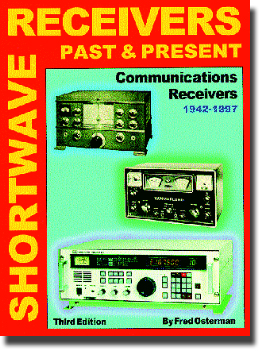 Shortwave Receivers Past and Present
Shortwave Receivers Past and Present by Fred Osterman. 3rd Edition, 1998.
One of the things I hate about collector's guides is that they try to cover too much and do too little of everything. Some just list names, model numbers and prices and add a few photos. Some have photos of many things, which is useful for identification, but little else. Some offer lots of data but few photos, which is great if you know what you have but worthless if you're trying to identify it.
This book does a far better job. By only concentrating on shortwave receivers, it cuts down the field to a still-huge but more managable number. Each rig gets its own little section, typically two to a page. Information includes the manufacturer's logo from the period, the model number, a good photo, and a list of key features, specifications, tube compliment (if used), accessories, and some brief comments. The author also notes where and when it was manuactured, its size and weight, whether it's currently manufactured, where and when it was reviewed in major magazines (e.g. QST), and how how common it is (abudant, common, scarce). There's also the obligatory price rating, which I would take with a grain of salt but at least gives you an idea of what to expect.
It's a full-size-magazine-sized book, so it's would be a bit of a handful to take to a swap meet or ham-fest, but great for looking up stuff on eBay or Antique Radio Classified or other sellers.
If you buy, or are thinking of buying, used equipment, this is a very nice resource to have. The only bad part is that the 3rd edition (the one I have) only goes through 1997.
As I type this, there's a brand new 4th Edition now available that brings us up to 2014. Amazon wants $150 for it in hardcover; hopefully the price will come down to earth in a softcover format.
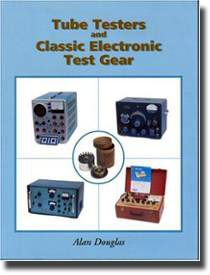 Tube Testers and Classic Electronic Test Gear
Tube Testers and Classic Electronic Test Gear by Alan Douglas. 2nd printing, 2008.
I believe this began as a book about old tube testers (though there are very few that aren't old), and the "Classic Electronic Test Gear" got tacked on to pad it out. The first half is tube testers and the second half is everything else.
I'm not knocking it, but it definitely looks like a lot of niche books from small publishers where the books are organized in an "eclectic" manner. This one's better than most, but it's still in that camp.
The first half is about tube testers, and it breaks into two sections. The first deals with testers in general: how they work, their (many) shortcomings, and a serious attempt to explain why there are apples, oranges and all manner of fruit when comparing them, even though they supposedly all do the same thing in a similar manner. The good part about that is you learn something useful about these things; the bad thing is you probably won't trust any of them ever again.
The second section of tube testers deals with actual makes and models, categorized by maker. In come cases (e.g. Seco) you only get a smidgeon of information; the more popular makes like Hickok will have more data. But even then, what's available varies greatly from one to the next: in some cases there are little more than a couple of advertisements (e.g. Sylvania's machines), while Sencore's Mighty Mites are documented model-by-model.
The second half of the book deals with different kinds of test equipment: VOMs, VTVMs, q-meters, grid-dip meters, C-and-L meters, signal generators, signal tracers and oscilloscopes. Here the models covered and discussed are mainly just representative of the group. In some cases, such as the VOM, there's some background on the machines as a whole, but overall it's thin. The VTVM section in particular surprised me with its paucity of info.
Overall, I like the book and I'm glad I bought it. It has been an interesting read and as a resource it's better than nothing. But for potential buyers I suggest moderating your expectations. Also: the book is available in generous preview mode in Google Books, so definitely look it over first.
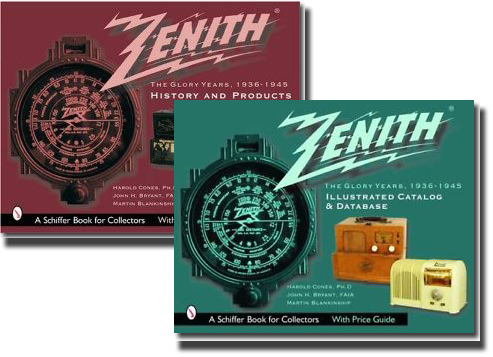 Zenith Radio, the Early Years and The Glory Years
Zenith Radio, the Early Years and The Glory Years by Harold N. Cones, John H. Bryant, Martin Blankinship and William Wade. 1997 and 2003
There are three books in this series so far. The first is Zenith Radio, the Early Years: 1919-1935. The second is Zenith Radio: The Glory Years: 1936-1945 (red cover, pictured). The third book is also called Zenith Radio: The Glory Years: 1936-1945, but it has a gray cover with different radios on the cover. The gray cover is an "illustrated catalog and database."
Both The Early Years and The Glory Years (red cover) deal with the history of Zenith radio from its humble beginnings borrowing spare manufacturing space from QRS to full-flower at the end of World War II. As I type this (2012) there isn't yet a book to take us into the jet age.
The gray cover Glory Years: Illustrated Catalog and Database is similar to what you typically see in other collectors' books: a model-by-model list and guide. The first half is a collection of Zenith radio illustrations as they appeared in advertisements and catalogs (e.g. Sears and Wards). They're shown chronologically by year, so it's relatively easy to find a given set if you're trying to indentify something.
The second half of the book is a printed database, including a year of production, the model number, name, "style" (e.g. console, table top, auto), chassis number, original MSRP, and more. There are liberal notes, other useful indices and tables, even a bit about pre-war record changers. A casual collector won't care much about this, but anyone who's more enthusiastic about old radios, especially Zeniths, should be thrilled.
If you like Zeniths (and I do), these are fantastic. It's not just a collector's guide, and it's not just a dry corporate history. It's a beautifully put-together book of heavily researched information and a ton of high-quality illustrations of all kinds. There are photos of various Zenith models, advertisements, factory photos—you name it. More manufacturers should rate books like this.
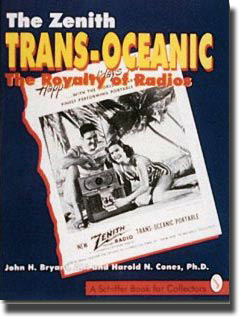 The Zenith Trans-Oceanic: the Royalty of Radios
The Zenith Trans-Oceanic: the Royalty of Radios by John H. Bryant and Harold N. Cones. 1995, 1st Edition
I have the first edition (cover shown). There's a more recent 2nd edition, red cover with various models on it. I haven't seen it so I do not know what (if any) differences there are between them.
This is similar to the Zenith Radio books except that the focus is just on the Trans-Oceanic line. There's a lot of information on the history, manufacture and culture of the beloved T-O. This includes the luggable wood-cabinet era, the solid-state era, and the related precursors and companion units.
It's a collector's resource, not a repair and restoration guide. For schematics, shop notes, hints and kinks, and other advice on fixing these beauties, you'll still have to search the net. But if you're interested in T-Os and just want to know more about them, it's an excellent book.
